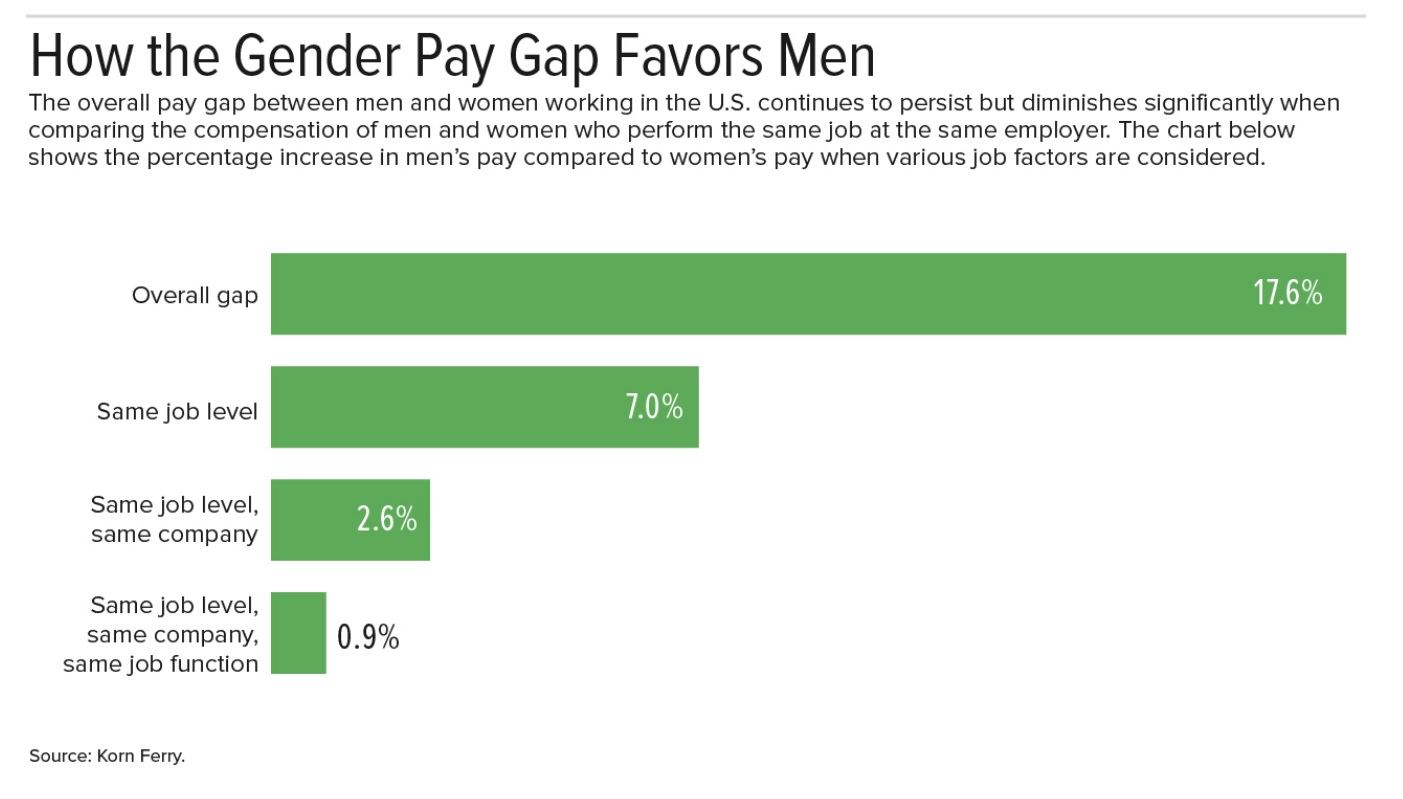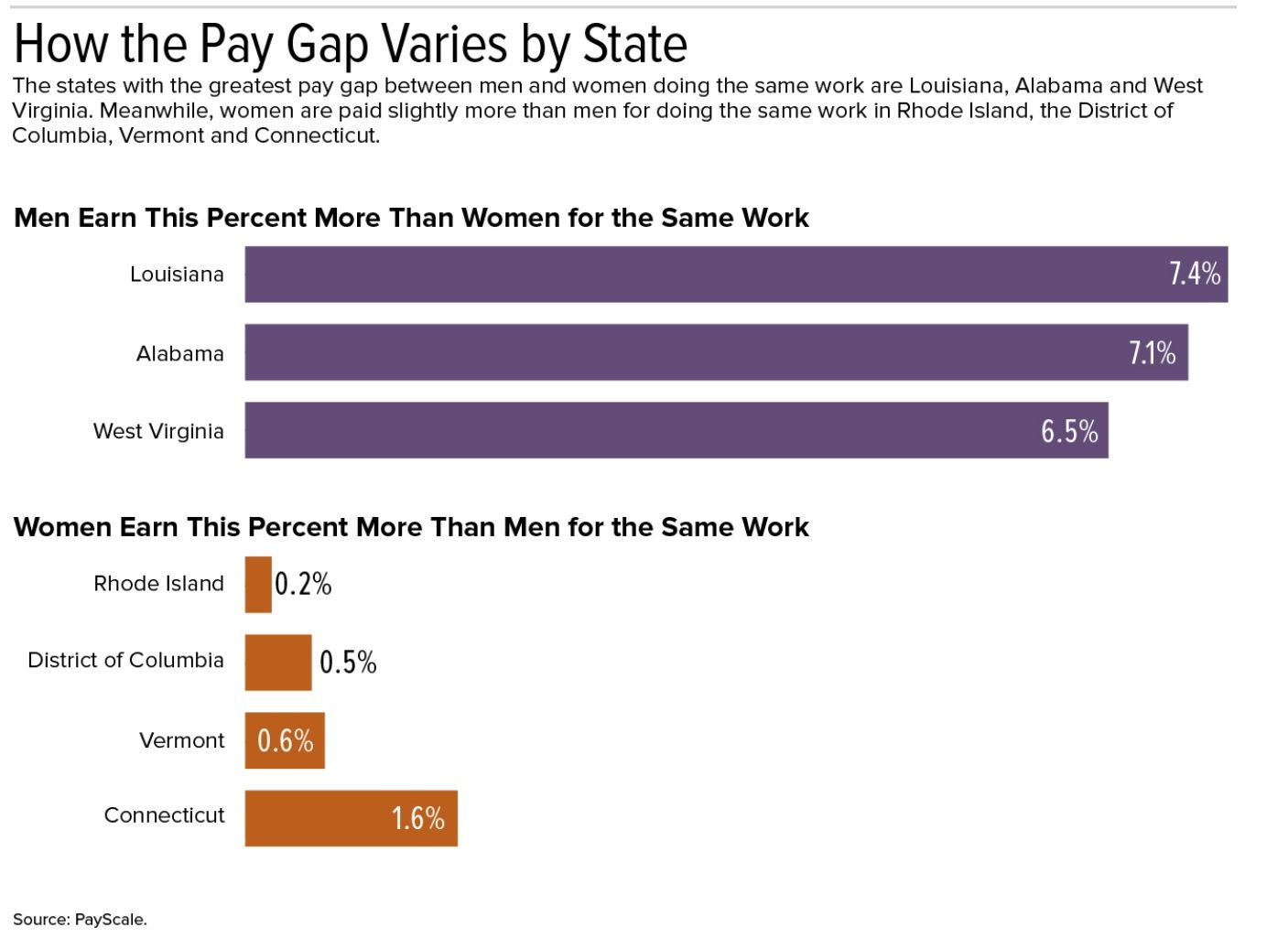
New findings reveal reasons behind inequalities in male and female pay
Women in the U.S. earn 17.6 percent less than men on average, but that gap virtually disappears when analyzing men and women who work at the same level at the same company and perform the same function, according to new research findings from pay consultancy Korn Ferry.
"The much-publicized pay gap between men and women in the U.S. is real, but it is predominantly caused by fewer women than men in higher-paying roles and higher-paying industries," said Korn Ferry senior client partner Maryam Morse, whose firm analyzed information from more than 1.3 million employees at 777 companies in the U.S.
Similarly, a new report from PayScale, a compensation data and software firm, found that:
*In 2018, women overall earn 77.9 cents for every dollar earned by men across the U.S. labor market (defined as the uncontrolled pay gap), up from 76 cents on the dollar in 2016.
*When factors such as experience, industry and job level were taken into account, women earn 97.8 cents for every dollar earned by their male peers for doing the same work (the controlled pay gap), virtually unchanged from two years earlier.
The findings in PayScale's The State of the Gender Pay Gap 2018 report are based on the firm's survey of over 2 million U.S. employees polled through February 2018.
There is heightened awareness of pay equity issues because of Equal Pay Day, started by the National Committee on Pay Equity in 1996 to highlight the gap between men's and women's wages. This day, on April 10 this year, symbolizes how far into the year women must work to earn what men earned in the previous year.

A 'Career-Break' Penalty
Men still move into more-senior positions at significantly higher rates, underscoring the opportunity gap problem, PayScale found.
One reason is that women are five times more likely than men to take extended leaves from working for child rearing, and that time away is more likely to last more than a year, the research showed.
When employees leave the workforce for one year or more, PayScale found, their pay on returning to work is 7 percent less than that of an employee who is already employed when seeking the same job. Since women leave the workforce more often than men, and their time away tends to last longer, they are disproportionately affected by lower pay due to career interruptions.
The report also shows that as employees progress through their careers, men are far more likely to find themselves in executive positions with bigger paychecks than their female counterparts. A breakdown:
- Men and women enter the job market at similar junior levels.
- By midcareer, men are 70 percent more likely than women to be in executive positions.
- By late career, men are 142 percent more likely to be in vice president or C-suite roles, which are typically the most highly compensated positions at a company.
"The current business climate has created a new focus and even spurred new laws aimed at achieving equal pay, but it's not enough," said Lydia Frank, vice president at PayScale. "Employers need to go a step further and determine if women have the same opportunities for advancement as men at the organization."

Closing the Gap
This pay gap issue can be remedied if organizations address pay parity across the organization "and continue to strive to increase the percentage of women in the best-paying parts of the labor market, including the most-senior roles and functions such as engineering and technical fields," Morse said.
Pay parity "can be addressed if there is an ongoing effort to enable and encourage talented women to take on and thrive in challenging roles," added Jane Edison Stevenson, Korn Ferry's global leader for CEO succession. "Women have the skills and competencies needed to ascend to the highest levels within organizations, and it should be a business imperative for companies to help them get there."
The disparity among men and women on executive teams and boards "has a huge impact on the overall pay gap, looking at the labor market as a whole," Frank said. "We'll never close the pay gap if we don't get serious about solving the opportunity gap."
To do so means thinking about "policies and work culture changes to help balance the burden between the genders of caring for children and other family members, and alleviate the career and pay impact for women," Frank advised.
Employers should think about providing paid parental leave regardless of gender, onsite child care and flexible work arrangements, she recommended.

A Transparency Gap
Small and mid-size businesses (SMBs) have a gender pay gap that exceeds the national average—female SMB employees make 66 cents for every dollar paid to men—and a lack of transparency around compensation practices is a key reason why, according to new researchby benefits management software firm Zenefits.
The firm's SMB Fair Pay Report is based on a March 2018 survey of 1,002 full-time employees and 401 business owners and HR decision makers. Respondents worked at companies with less than 500 employees. Among the findings:
- 78 percent of men and 67 percent of women discuss their salary expectations at the beginning of a job interview, yet when an offer is made, 55 percent of men compared with only 36 percent of women indicated they negotiated their actual offer.
- The gap widens when it comes to asking for a raise; 62 percent of men compared with 41 percent of women felt comfortable asking. Furthermore, 17 percent of men compared with 8 percent for women will counter raises they are offered (i.e., ask for more money).
- Only 13 percent of small businesses are transparent with their employees about pay policies and rates. Because this minimizes the need for people to negotiate, employees at transparent companies are 22 percent more likely to feel equitably paid.
"Self-advocacy and negotiation are two major factors in perpetuating the gender pay gap," said Beth Steinberg, chief people officer at Zenefits. "Teaching people to negotiate better is a flawed solution to the issue. True compensation fairness will come when employers become more transparent in their pay policies."

***** ***** ***** ***** *****
Source: Society for Human Resource Management (SHRM)
https://www.shrm.org/ResourcesAndTools/hr-topics/compensation/Pages/gender-pay-gap-closure-requires-career-parity.aspx
